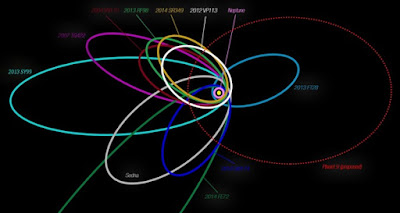Topics: Astronomy, Astrophysics, Exoplanets, Space Exploration
Note: Not an April 1st joke. With the COVID-19 crisis, I literally had to peruse some sites that DIDN'T talk about what we're all living through. It's been rough, thinking about how and when this all ends. I'll try to get my sea legs back to blogging about science. Bear with me. I'm human.
Astronomers have discovered 139 new minor planets orbiting the Sun beyond Neptune by searching through data from the Dark Energy Survey. The new method for spotting small worlds is expected to reveal many thousands of distant objects in coming years — meaning these first hundred or so are likely just the tip of the iceberg.
Taken together, the newfound distant objects, as well as those to come, could resolve one of the most fascinating questions of modern astronomy: Is there a massive and mysterious world called Planet Nine lurking in the outskirts of our solar system?
Neptune orbits the Sun at a distance of about 30 astronomical units (AU; where 1 AU is the Earth-Sun distance). Beyond Neptune lies the Kuiper Belt — a comet-rich band of frozen, rocky objects (including Pluto) that holds dozens to hundreds of times more mass than the asteroid belt. Both within the Kuiper Belt and past its outer edge at 50 AU orbit distant bodies called trans-Neptunian objects (TNOs). Currently, we know of nearly 3,000 TNOs in the solar system, but estimates put the total number closer to 100,000.
As more and more TNOs have been discovered over the years, some astronomers — including Konstantin Batygin and Mike Brown of Caltech — have noticed a small subset of these objects have peculiar orbits. They seem to bunch up in unexpected ways, as if an unseen object is herding these so-called extreme TNOs (eTNOs) into specific orbits. Batygin and Brown — in addition to other groups, like that led by Scott Sheppard of the Carnegie Institution for Science — think these bizarrely orbiting eTNOs point to the existence of a massive, distant world called Planet Nine.
Hypothesized to be five to 15 times the mass of Earth and to orbit some 400 AU (or farther) from the Sun, the proposed Planet Nine would have enough of a gravitational pull that it could orchestrate the orbits of the eTNOs, causing them to cluster together as they make their closest approaches to the Sun.
The problem is that the evidence for Planet Nine is so far indirect and sparse. There could be something else that explains the clumped orbits, or perhaps researchers stumbled on a few objects that just happen to have similar orbits. Discovering more TNOs, particularly beyond the Kuiper Belt, will allow astronomers to find more clues that could point to the location of the proposed Planet Nine — or deny its existence altogether. Of the 139 newly discovered minor planets found in this study, seven are eTNOs, which is a significant addition to a list that numbered around a dozen just a few months ago.
Astronomers find 139 new minor planets in the outer solar system
Erica Naone, Astronomy

Comments